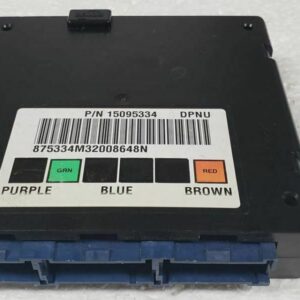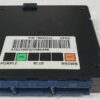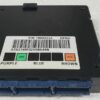Tired of Your Truck’s Unpredictable Electronics?
Are you dealing with a 2002 GMC Sierra or another GM vehicle that seems to have a mind of its own? Maybe the power windows work one minute and not the next, the interior lights flicker randomly, or the radio suddenly dies. These aren’t just annoyances; they’re classic signs that the central command center for your vehicle’s accessories—the Body Control Module (BCM)—is failing. When the BCM goes bad, it can cause a cascade of frustrating, seemingly unrelated electrical problems that can be a nightmare to diagnose. This isn’t just a part; it’s the solution to restoring order and reliability to your vehicle’s essential functions.
Case Study: A Tricky Diagnosis
I remember a 2002 Sierra 2500 that came into my shop a few months back. The owner was at his wit’s end. His main complaint was an intermittent no-start, but he also mentioned the security light would stay on, and his power door locks were completely dead. He’d already replaced the battery and checked the fuses. After connecting my scan tool, I saw a slew of communication fault codes (U-codes) pointing to a network issue. In my 20+ years of experience, when you see a mix of security, power accessory, and communication failures on these GM trucks, the BCM is the prime suspect. We installed a VIN-programmed BCM, and it was like flipping a switch—the truck started every time, the locks worked, and all the codes cleared. This is a common failure, and a correctly programmed module is the definitive fix.
Common Signs of a Failing BCM
- ✔ Erratic or non-functional power windows, door locks, and mirrors.
- ✔ Interior or exterior lights that flicker, stay on, or won’t turn on at all.
- ✔ The security or anti-theft light stays illuminated, potentially causing a no-start condition.
- ✔ Dashboard gauges behaving erratically or not working.
- ✔ The radio or infotainment system randomly shutting off.
- ✔ Diagnostic trouble codes related to communication loss with the BCM, such as U0140.
- ✔ Horn sounding unexpectedly or not working when pressed.
A Straightforward Guide to BCM Installation
Installing your new Body Control Module is a manageable job for a confident DIYer. The location varies slightly by model, but the process is similar. For most Sierra, Silverado, and other full-size trucks/SUVs, you’ll find it under the driver’s side of the dashboard, near the steering column. For vans like the Astro/Safari or smaller SUVs like the Blazer, it’s often located behind the center dash panel.
- Safety First: Always disconnect the negative terminal from your vehicle’s battery before starting any electrical work.
- Locate the BCM: Find the module under the dash. It’s a plastic box with several large multi-pin electrical connectors.
- Disconnect the Connectors: Carefully release the locking tabs on each electrical connector and pull them straight out from the module. Do not force them.
- Remove the Module: The BCM is typically held in place by a few bolts or clips. Remove them and slide the old module out of its bracket.
- Install the New BCM: Slide your new, pre-programmed module into place and secure it with the original hardware.
- Reconnect Everything: Firmly plug all electrical connectors back into the new BCM. You should hear a ‘click’ as they lock into place. Reconnect the negative battery terminal.
Important Post-Installation Steps
Because this BCM is pre-programmed to your VIN, most functions should work immediately. However, depending on your vehicle’s specific configuration, a couple of additional steps, known as relearn procedures, might be necessary. These require a bi-directional scan tool.
- Airbag System Sync: If your airbag warning light is on after installation, a professional will need to perform the “Setup SDM Primary Key in BCM” procedure to sync the modules.
- Brake Pedal Position Relearn: On some models, a brake pedal sensor recalibration may be needed to ensure proper brake light and stability control operation.
There is NO core charge for this part. You can keep your old BCM.
Will This Fit My Vehicle?
This Body Control Module is a direct replacement for part number 19208537 and also interchanges with part numbers 15063578, 15081796, 15095334, DKAK, and DPNU. It is confirmed to fit the following GM vehicles:
AVALANCHE 1500 (2002, 4×2)
ASTRO VAN (2002-2005)
BLAZER S10 (2002-2005)
S10 PICKUP (2002-2004)
SILVERADO 1500, 2500, 3500 (2002)
SUBURBAN 1500, 2500 (2002, 4×2 for 1500)
TAHOE (2002, 4×2)
GMC:
JIMMY S15 (2002-2005)
SAFARI VAN (2002-2005)
SONOMA S15 (2002-2004)
SIERRA 1500, 2500, 3500, DENALI (2002)
YUKON & YUKON XL 1500, 2500 (2002, 4×2 for 1500 models)
Cadillac:
ESCALADE (2002, 4×2)
Frequently Asked Questions
How does the VIN programming work?
After you place your order, you will need to provide us with your vehicle’s 17-digit VIN. We use this number to load the exact, factory-correct software and calibrations for your specific vehicle onto the BCM before we ship it. This ensures maximum compatibility and function right out of the box.
What is a BCM and what does it do?
The Body Control Module (BCM) is a computer that acts as the central hub for your vehicle’s body electronics. It controls functions that aren’t related to the engine, like power windows, locks, interior/exterior lighting, the security system, wipers, and the horn.
Do I need to send my old BCM back?
No. We do not require you to return your original module. There is no core charge associated with this purchase, saving you the hassle and expense of a return shipment.
Will this fix my ‘Service 4WD’ light?
While the BCM communicates with many modules, a ‘Service 4WD’ message is typically caused by the Transfer Case Control Module (TCCM) or a faulty encoder motor or switch. A failing BCM is less likely to be the direct cause of that specific message.
Is it guaranteed to fix my problem?
This BCM will fix any issue directly caused by a faulty Body Control Module. It’s crucial to properly diagnose the issue first, as similar symptoms can sometimes be caused by wiring or switch problems. Our description of common symptoms is a great guide for diagnosis.
What tools do I need for the post-installation procedures?
The Airbag System Sync and Brake Pedal Position Relearn must be performed with a professional-grade, bi-directional diagnostic scan tool. Many local repair shops can perform these procedures for you if they are required.



